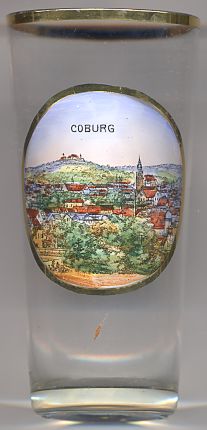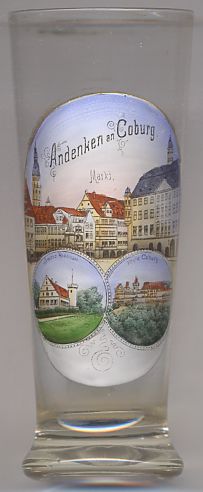

|
| DEUTSCHLAND | GERMANY |
| Bundesland: Freistaat Bayern | Bavaria |
| Regierungsbezirk: Oberfranken | |
| Stadt: Coburg |
 Coburg is situated at an elevation of 296 m between the southern foothills of the Thüringer Wald low mountain region
and the Main valley in northern Upper Franconia. Coburg has a population of about 42,000 (2005). The city, which is
administered as a district in its own right, is also the seat of the administration of the district (Landkreis) Coburg.
Coburg is situated at an elevation of 296 m between the southern foothills of the Thüringer Wald low mountain region
and the Main valley in northern Upper Franconia. Coburg has a population of about 42,000 (2005). The city, which is
administered as a district in its own right, is also the seat of the administration of the district (Landkreis) Coburg.
The earlies written mention of Coburg is found in a document of 1056. In 1331 Emperor Ludwig IV ('the Bavarian') granted Coburg the privileges of a town. In 1353 Coburg was inherited by Margrave Friedrich III of Meißen and thus came in possession of the House of Wettin. In 1485, following the Partition of Leipzig, Coburg became part of the countries of the Ernestine line of the House of Wettin (see chart). After the partition in 1572, Coburg was one of the centres of the duchy Saxe-Coburg-Eisenach, which in 1572 was partitioned again into Saxe-Coburg (Duke Johann Casimir; until 1633) and Saxe-Eisenach (until 1638). It was during this period that many of the city's typical Renaissance structures were built.
In the late 17th century (1680/1690), the Ernestine line of the House of Wettin was partitioned into a record 10 (ten) duchies:
House Weimar: Saxe-Weimar, Saxe-Eisenach (1662–1672/1741), Saxe-Jena (1662–1690);
House Gotha: Saxe-Gotha-Altenburg, Saxe-Coburg (1680–1699), Saxe-Meiningen, Saxe-Römhild (1680–1710),
Saxe-Eisenberg (1680–1707), Saxe-Hildburghausen and Saxe-Saalfeld.
In 1699, Saxe-Coburg was inherited by Saxe-Saalfeld, which in 1735 was renamed Saxe-Coburg-Saalfeld.
After the death in 1825 of the last duke of Saxe-Gotha-Altenburg, the Ernestine countries were reorganized in 1826 (see map):
The duke of Saxe-Hildburghausen lost his original country and received Altenburg (now duchy of Saxe-Altenburg) as compensation.
Saxe-Meiningen was awarded the Hildburghausen countries and also obtained Saalfeld and other smaller parts of Coburg-Saalfeld.
Saxe-Gotha (the remaining part of the former Gotha-Altenburg) and Saxe-Coburg
(the remaining part of the former Coburg-Saalfeld) remained independent duchies, but now were ruled in personal union by
Duke Ernst I who thus founded the line Saxe-Coburg and Gotha.
The new territory consisted of two independent duchies with two separate administrations, and
the ducal court moved twice a year between the two residence towns of Coburg and Gotha.

During the late 19th century important parts of the town were rebuilt in historicist Gothic revival style. Due to the extent and its good state of preservation, this neo-Gothic part of the city's architecture is unique in all Europe. The monarchy ended on 14th November 1918 with the abdication of the last duke, Carl Eduard. In a referendum in the following year, 88% of the inhabitants of Coburg voted against becoming part of Thuringia and thus Coburg in 1920 became part of Bavaria.
The top picture on glass no. 2193 [right] shows the
 market
market town
town church
church
The bottom left picture depicts  castle Rosenau, which had been founded in 1424 as a moated
castle. Most probably it houses Coburg's mint up until the 17th century. In 1671 almost all parts of the structure except
the ground floor were pulled down and the upper floor was rebuilt in half-timbered style with a mighty gabled roof. In
the 19th century the building was modified again and was used as the ducal washhouse. After World war II it served
as depot of the municipal theatre before it was abandoned and began to fall into dereliction. In the late 1970s it
was thoroughly renovated and revitalised.
(Another castle named Rosenau is located in Rosenau, Austria.)
castle Rosenau, which had been founded in 1424 as a moated
castle. Most probably it houses Coburg's mint up until the 17th century. In 1671 almost all parts of the structure except
the ground floor were pulled down and the upper floor was rebuilt in half-timbered style with a mighty gabled roof. In
the 19th century the building was modified again and was used as the ducal washhouse. After World war II it served
as depot of the municipal theatre before it was abandoned and began to fall into dereliction. In the late 1970s it
was thoroughly renovated and revitalised.
(Another castle named Rosenau is located in Rosenau, Austria.)
The  Veste Coburg [bottom right] is one of the best preserved castles in Germany.
Located 167 m above the city, its impressive dimensions (135 by 260 metres) also make it one of the country's
largest of its kind. The earliest document that mentions the castle dates from 1225 and refers to it as a possession of
the dukes of Andechs-Merania. In 1248 the castle passed to the counts of Henneberg, in 1291 to
the margraves of Brandenburg, and in 1312 again to the Henneberg counts. In 1353 it was inherited by Friedrich III
('the Austere') of Meißen and remained in possession of the House of Wettin until the end of the
monarchy in 1918. In 1530, the reformer Martin Luther stayed several months in the castle as he was not allowed to
travel to and participate in the Diet of Augsburg, because in 1521 he had been put under
'Reichsacht' by the Edict of Worms for for spreading heretic beliefs and splitting the church.
Veste Coburg [bottom right] is one of the best preserved castles in Germany.
Located 167 m above the city, its impressive dimensions (135 by 260 metres) also make it one of the country's
largest of its kind. The earliest document that mentions the castle dates from 1225 and refers to it as a possession of
the dukes of Andechs-Merania. In 1248 the castle passed to the counts of Henneberg, in 1291 to
the margraves of Brandenburg, and in 1312 again to the Henneberg counts. In 1353 it was inherited by Friedrich III
('the Austere') of Meißen and remained in possession of the House of Wettin until the end of the
monarchy in 1918. In 1530, the reformer Martin Luther stayed several months in the castle as he was not allowed to
travel to and participate in the Diet of Augsburg, because in 1521 he had been put under
'Reichsacht' by the Edict of Worms for for spreading heretic beliefs and splitting the church.
![[scale]](lineal.jpg)